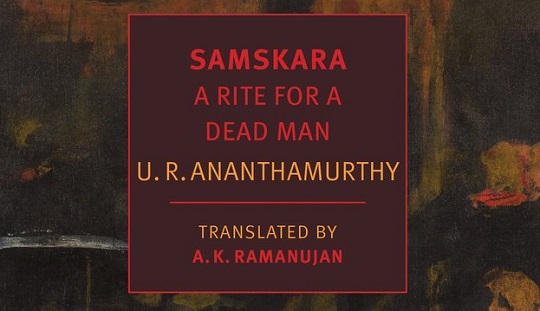NYRB Classics’ reissue of this book comes at an opportune moment, as societies around the world face the dangers of religious extremism and its focus on ritual and regulation rather than humanity. U.R. Ananthamurthy, in A.K Ramanujan’s translation from the Kannada, tries to teach Indian society a lesson in this story about the trouble with prioritizing tradition over compassion.
Samskara begins with one of the central cleansing and purification rituals in the rites of Hindu worship. Praneshacharya, the most respected Brahmin in his traditional and conservative agrahara, begins each day by bathing the sickly and desiccated body of his infirm wife. Praneschacharya has faithfully carried out this ritual for more than twenty years. He views sexless marriage as a penance and a sacrifice that will deliver salvation in this life and in the next. But the death of an impious and sinful Brahmin, Naranappa, in the agrahara brings Praneshacharya to a spiritual crisis of his own that makes him question his long-practiced rituals and beliefs. The cleansing ritual that he performs on his wife at the beginning of the story is the last time that he will perform this expiating routine; this is the beginning of the end for Praneshacharya’s spiritual cleanliness and purity.
Samskara—the compulsory rite given to Brahmins at their passing—becomes the central controversy of the novel. Naranappa has renounced the Brahmin rituals of the agrahara and has carried out the most outrageous and offensive acts to show his disapproval of his fellow worshippers and neighbors. He’s taken up excessive drinking, spent time with Muslims and ate meat with them, and caught fish from the sacred temple pond. The most impious of his actions, however, was casting off his lawful wife and his choosing to live with a lower class, outcast woman named Chandri. Despite his hedonistic behavior, the Brahmins never excommunicated Naranappa from their small, conservative village.
It is Chandri, Narranappa’s low-born lover, who delivers the news of his death to the agrahara. This announcement causes an immediate conflict over the performance of the death rites for this blasphemous man whom they continued to allow to live among them. The Brahmins’ failure to act in the face of Naranappa’s sacrilege can be viewed as the first of Ananthamurthy’s many criticisms of the Brahmins way of life; their laziness or fear or lack of conviction, or a combination of all three, prevent them from expelling Narranappa from the agrahara. Now that he has died, none of them want to be responsible for performing the death rites for his body.
READ MORE…



